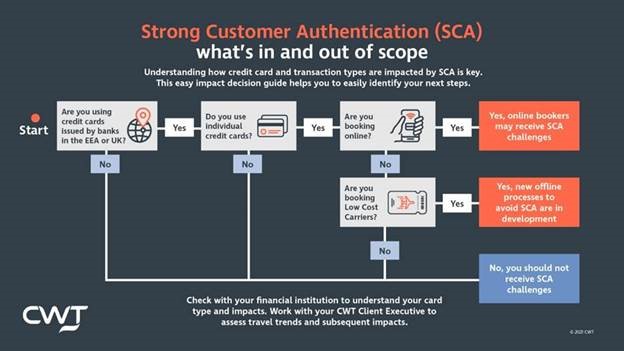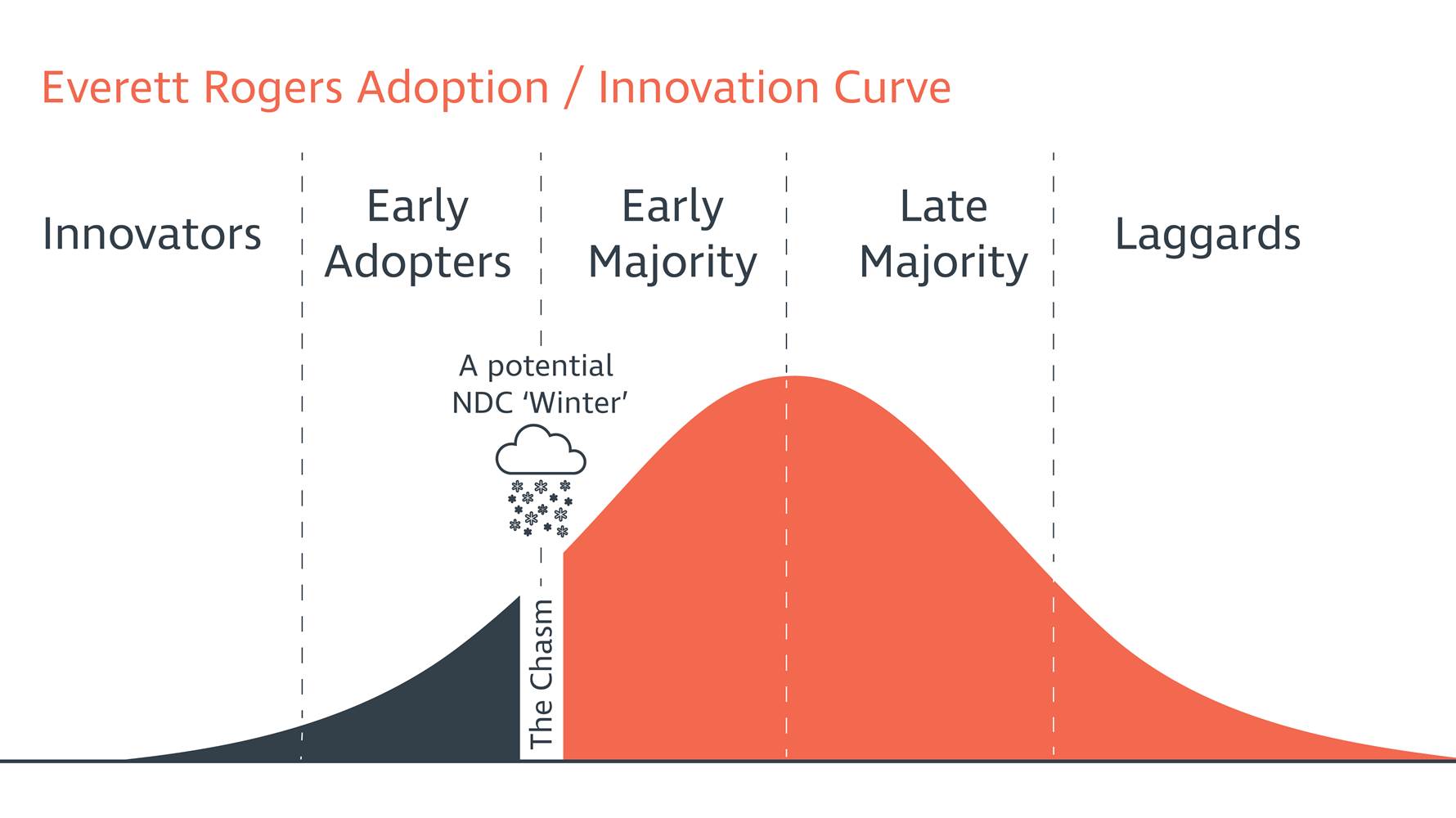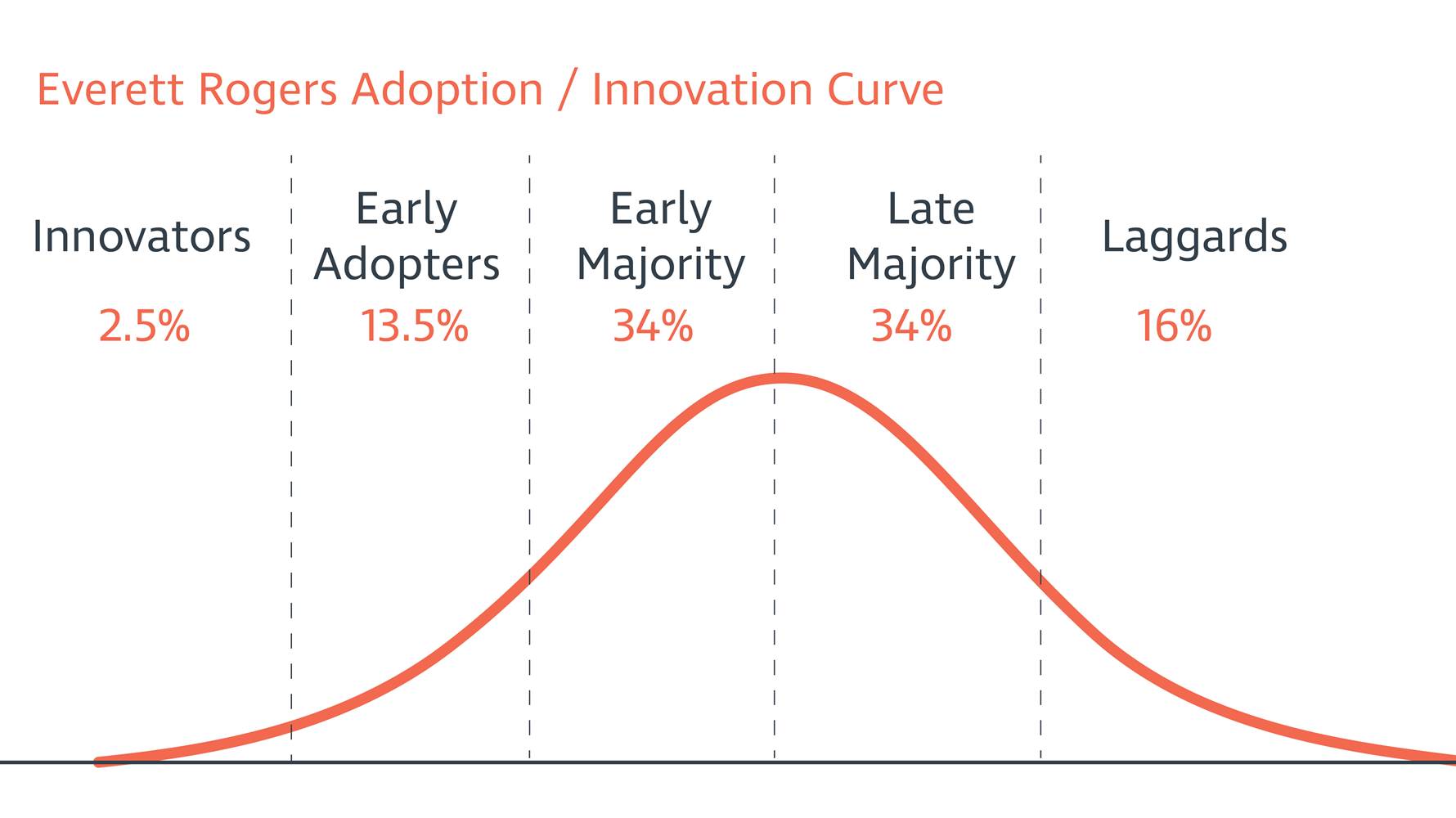Introducing the latest myCWT product and service enhancements
Building on our digital, omnichannel myCWT platform, our new products and services will simplify travel management for you and your employees – anytime, anywhere, anyhow.
Note: Featured services may not be available in your country at this time. Please reach out to your CWT representative for more details.
Hear from Chief Product Officer, Erica Antony as she shares the key product highlights of 2024, along with the key areas driving innovation.
-

2040: Baseline, Boom or Bust
As we enter an era of rapid transformation and unprecedented challenges, it is essential for travel managers, meeting & event planners, and corporate decision-makers to look ahead and frame our current strategic thinking with a clear vision of the future. Business travel and meetings and events (M&E) are poised for significant change over the next decade and a half, driven by a complex interplay of sustainability goals, technological advancements, evolving work models, and geopolitical dynamics.
In this paper to mark the 10th anniversary of our Global Business Travel Forecast, we explore, for the first time, a long-term vision of the future and potential trajectories through three distinct scenarios, each offering insights into how these forces should affect policy-making, budgeting and priorities. By examining these scenarios, we can better understand the diverse possibilities that lie ahead and the strategic imperatives required to thrive in each potential future.
Based on trajectory data analysis and interviews with industry leaders, behaviorists and climate tech founders, this forward-looking approach enables us to anticipate changes, strengthen our strategies, and make informed decisions that align long-term objectives. It is through this lens of foresight and adaptability that we can build resilience, seize opportunities, and navigate the complexities of the future.
We invite you to reflect on the insights presented, and consider how your organization can prepare for the opportunities and challenges that lie ahead. Together we can ensure that travel and meetings remain catalysts for growth, scalability and sustainable practices.
- Scenario development is both an art and a science
- Megatrends Shaping the Future of Business Travel, Meetings and Events
- Sustainability goals the new crux of corporate policy
- Technology Revolutionizes Travel Management
- Modern work models spark new travel patterns
- Changing demographics open doors to new opportunities
- Three Scenarios: Base case, boom and bust
- Future-proofing strategies

-

CWT GBTA Global business travel forecast 2025
When it comes to pricing, global business travel has finally reached an enduring, higher baseline. Prices will continue to rise in 2025, but only moderately, so expect a period of normalized growth.
However, this pricing environment, one of marginal gains and price regularity, is fragile. Global leisure travel has now realized a lot of its pent-up demand, while corporate travel has been resurgent, with 2024 edging at preCovid levels.
There are many factors at play, whether its volatile oil prices, labor costs and constraints, inflationary pressures, and geopolitical factors. As this elevated baseline edges upwards, albeit marginally, travel budgets will come under increased scrutiny, especially as travel patterns and attitudes change.
It’s why business travel can’t be viewed in a silo, and the true value to an organization must be fully realized. This forecast can help with those calculations.

-

Capitalize on emerging technologies in corporate travel
Technological advancements are accelerating at an unprecedented pace. How will emerging innovations like Generative AI, blockchain, and self-sovereign identity (SSI) transform corporate travel?
BTN and CWT probed global CEOs, travel managers, industry consultants and tech experts on the promises, questions, and expectations these innovations raise and how they are set to reshape traveler experience, cost control and service delivery in corporate travel and events.
Download and discover
- The technologies that will have the greatest impact on corporate travel in the next 2-5 years
- How these emerging technologies are poised to control costs, enhance service and security, and boost efficiency
- The critical challenges, opportunities, risks and roadblocks each innovation raises
- What travel managers, buyers and experts anticipate from these innovations

-

CWT appoints Lisa Baez as Senior Director Information Security
CWT,the Business-to-Business-for-Employees (B2B4E) travel management platform, has appointed Lisa Baez as Senior Director Information Security. Based in Minneapolis and reporting to Harshal Mehta, CWT’s Chief Information Security Officer, Lisa will be part of the company’s Risk and Security Team.
“Lisa will play a key role in the continuous development of our robust corporate risk & security program, and I am delighted to welcome someone of Lisa’s extensive experience to our team,” said Harshal Mehta, CWT’s Chief Information Security Officer.
Lisa joined CWT from Defense and Aerospace industry leader, Northrup Grumman, where she was Sector Chief Information Security Officer. Prior to that, she held various security, information protection, risk and compliance roles with AgriBank, Carlson, MoneyGram International, Orbital ATK, and Target.
A graduate of St. Mary’s University of Minnesota, Lisa also holds certifications from ISC2 (the International Information System Security Certification Consortium), IAPP (the International Association of Privacy Professionals) and ISACA (the Information Systems Audit and Control Association).
CWT is a leading global partner in business travel, meetings, and events. Operating across six continents, we deliver sustainable, tailored solutions that help organizations connect, engage, and thrive in an evolving world. Our myCWT platform integrates advanced technology with human expertise to simplify travel and enhance traveler and attendee experiences. Extensive global coverage, seamless data integration, AI-driven analytics, and carbon-conscious travel tools enable businesses to optimize their travel and meetings programs while delivering measurable value.
With 150 years of industry experience and a deep commitment to partnership, CWT collaborates with clients to shape the future of business travel and events, making them more efficient, responsible, and impactful.
-

Getting back to travel: 3 things we learned from the pandemic
The pandemic prompted us all to think differently about our lives – what mattered most, getting the correct balance of work and homelife when each invariably crept into the other, and what we wanted and expected on the other side. The same can be said of travel: it was one of the worst hit industries and, in order to withstand the challenges, had to pivot and innovate. Business travel has changed forever, but that’s not necessarily a bad thing. There are some interesting lessons to be learned and new ways of working that we should all continue to stay accustomed to.
Human versus hybrid
At a time when we were forced to socially distance, work remotely and connect virtually with one another we never thought we would crave human in-person connections so much. But human beings have a natural need for human interaction, it is essential to our society and to wellbeing. Face-to-face meetings are key to building strong relationships; they allow you to better read hand gestures, body language and facial expressions. Often things can be misinterpreted when on a video chat and especially over email or instant message.
There are however some situations where meeting virtually does actually work well such as when conducting smaller internal meetings where a virtual solution can be efficient.
If you take a look at the meetings & events industry the pandemic boosted the market for virtual and hybrid meeting solutions. The technology behind those solutions improved a lot, although they will never replace in-person meetings. The hybrid format has proven to be a good step forward for larger gatherings. “A great advantage is that you broaden your audience with the hybrid format”, says John Pelant, Chief Information Officer of CWT. “Employees who previously were not able to travel to a large meeting can join virtually and the people that you want in the room are there anyway. I think we will see that trend continue as we move forward.”
Data management
“Data will absolutely be a critical element in the business travel industry, even more so than today. From travel spend data to digital health data, this will be a vital part of the role of the TMC in the future”, says Michelle Frymire, Chief Executive Officer CWT.
The importance managing data has been pushed to the forefront in the last 18 months.”The pandemic is demanding a whole new layer of real time data – including health data – in how companies look at and manage the safety and security of their employees. This will be a focus for several years coming,” says John Pelant. “TMC’s are working with their customers to strike that right balance of the travelers personal data: how to look after the safety of their travelers and protecting their privacy at the same time.”
Proper data management is also about what data is available in each country, does it need to stay in that country and who has access. “That is where the complexity comes in”, according to John Pelant. “The challenge will be how we can make sure that the data is stored at a proper level and probably only the minimum that needs to be used to make that an easy solution for a traveler but protect others. It also comes down to ownership. Private companies are likely to come forward to fill that space, but that will be a future battleground. We don’t have the answers yet, it needs to play out when we go forward.”
Traveler experience is key
The times when traveling was purely functional are over. The tide has turned, nowadays travelers want a seamless travel experience that fits their personal needs. The pandemic (re)started the discussion around essential travel. Not only from a cost perspective but also from a traveler wellbeing one. “Companies will want to make sure the experience is even better for their employees than it was before,” says Michelle Frymire. “And that is where we play a vital role – the ‘next normal of business travel’ is more efficient, easier to manage, but also very experience driven. TMC’s will play a key role in ensuring safe, efficient and meaningful experiences for employees when traveling and that the value of our clients travel spend is maximized even further than it is today.”
Image credits: Adobe Stock
-

CWT exceeds 2021 messaging integration targets with 1,000th customer adoption
CWT, the Business-to-Business-for-Employees (B2B4E) travel management platform, today announced it has reached a key milestone for its messaging solution, with over 1,000 businesses in more than 113 countries now using the service. After an initial 25-client launch in late 2019, CWT signed 300 more to the service across 2020, and over 675 more so far this year. CWT is currently onboarding several hundred clients across India, Brazil, Spain and France.
“We are proud to deliver to the needs of both customers and their travelers, as they turn to new channels for support. Our expanding messaging geographical presence, language capabilities and ensured swift traveler response times are pivotal to exceeding customer satisfaction as travel resumes,” said Niklas Andréen, CWT President & Chief Operating Officer. “Without doubt, messaging has become a key support platform and service tool for our customers and their travelers over the last 18 months.”
Available through myCWT, Microsoft Teams and Facebook Workplace, CWT messaging eliminates the need for customers to use separate applications, call, or email whilst en-route, and is backed by a team of specially trained messaging counselors offering a rapid, customized and efficient response service.
CWT is a leading global partner in business travel, meetings, and events. Operating across six continents, we deliver sustainable, tailored solutions that help organizations connect, engage, and thrive in an evolving world. Our myCWT platform integrates advanced technology with human expertise to simplify travel and enhance traveler and attendee experiences. Extensive global coverage, seamless data integration, AI-driven analytics, and carbon-conscious travel tools enable businesses to optimize their travel and meetings programs while delivering measurable value.
With 150 years of industry experience and a deep commitment to partnership, CWT collaborates with clients to shape the future of business travel and events, making them more efficient, responsible, and impactful.
-

Meet Joel Hanson, Senior Director of Global Innovation Business Development
Joel Hanson has been appointed as Senior Director of Global Innovation Business Development. In the last couple of years Minneapolis based Joel has played a vital role in the conceptualization and launch of several tools, products and services to optimize efficiency and the traveler’s end-to-end travel experience.
We chat with Joel on business travel innovations, his favourite movie and how a TMC should be coupling a collaborative spirit with an appropriate audacity to bring fresh perspective.
What do you perceive as the most important business travel innovation of the last couple of years and why?
The most important business travel innovation of the last couple years is the customer itself. Our clients are witnessing transformational change on so many fronts, and with those changes has come a new set of perspectives. To some extent, the past 18 months have produced kind of a sea change in consciousness, with people having a chance to reflect – perhaps more deeply than ever before – on what is important to them. Against that backdrop, I think business travel is arguably at its most fascinating inflection point ever.
In terms of technology, there are many innovations I could point to, but I would highlight ZeroAvia as particularly ground-breaking. They are pioneers in the area of hydrogen-electric aircraft and could help usher in a new era in sustainable business travel.
If you had not ended up in innovation business development what other career could you have pursued and why?
For several years I was a product manager across a variety of domains. I used to see that role as a combination of stand-up comedian, consultant and bull dog. The comedian helped influence, the consultant shed light, and the bull dog reflected the sheer tenaciousness needed. So had I not ended up in innovation business development, perhaps I would have been a consultant focused on emerging technologies. The intersection of change, technology and user experience would have found me one way or another.
What do you like to do to relax after a busy working day?
Every single day I try to allow room for some form of empty space, whether in the form of a walk, listening to music, a guided meditation to fully relax the body, or simply creating some white space on the calendar. Without this, it’s a bit like breathing the same exact air over and over – we all need fresh air every day, in every sense.
What is your favourite movie and why?
That’s a difficult one as I love so many. That said, I have to pick the movie Miracle: a story about a player-turned-coach who leads the 1980 USA Olympic hockey team to victory over the seemingly invincible Russian squad. It is such a fascinating study of leadership and teamwork and also has a bit of personal meaning to me because that hockey team practiced a few blocks from where I grew up. It’s an interesting reminder that amazing things can happen in your own backyard.
What do you think are the key aspects when looking out for a new TMC?
I think it’s a very subtle mixture of elements, and very high on the list are collaborative spirit coupled with an appropriate audacity to bring fresh perspective and an eye on what’s possible now – and next. Ultimately, I think clients want a bit of respectful challenging from their TMC, exploring what’s possible and having the time of their lives doing it.
-

CWT appoints Director of Global Supplier Management in China
CWT, the Business-to-Business-for-Employees (B2B4E) travel management platform, has appointed Laura Wang as Director of Global Supplier Management (GSM) China. In this role, Laura will lead the negotiation and implementation of air, ground transportation and hotel agreements to ensure robust, broad and value-optimized business travel products and services for all CWT China customers.
Heading up CWT’s GSM China team, Laura will also work with the global and regional GSM teams to ensure seamless and consistent supplier management and partnership processes, from negotiation to delivery of partnerships and business development.
Based in Shanghai and reporting into Wong Wai Mun, VP Global Supplier Management APAC, Laura brings over 20 years of travel trade experience and 12 years team management experience to CWT, having worked for Hotelbeds Group, GTA, FCM and United Airlines.
“Laura’s experience in managing people and businesses in China as well as her background in the supply management industry is a perfect fit for CWT”, said Wong Wai Mun, VP Global Supplier Management, APAC. “I am confident she has the ability to nurture, grow and develop our people, suppliers and the business in China, while continuing to harness our reputation as one of the world’s most respected travel management partners in the market.”
CWT is a leading global partner in business travel, meetings, and events. Operating across six continents, we deliver sustainable, tailored solutions that help organizations connect, engage, and thrive in an evolving world. Our myCWT platform integrates advanced technology with human expertise to simplify travel and enhance traveler and attendee experiences. Extensive global coverage, seamless data integration, AI-driven analytics, and carbon-conscious travel tools enable businesses to optimize their travel and meetings programs while delivering measurable value.
With 150 years of industry experience and a deep commitment to partnership, CWT collaborates with clients to shape the future of business travel and events, making them more efficient, responsible, and impactful.
-

NDC: Tipping the scale of NDC adoption
In my last blog Four Ways to avoid an NDC winter I discussed how overcoming the credibility gap between the early adopters and early majority was a critical stage in our NDC journey. For the final blog in this series, I discuss how focusing on product related factors can influence adoption as well. Unlike the movie Field of Dreams, where Kevin Costner is told ‘If you build it, he will come’, if we want NDC to hit some home runs, we need to do more than simply build. We must also focus our attention on the factors that will drive adoption.
There are several product related factors that influence adoption which can all be assessed by asking five simple questions:
1. Does the new product offer clear benefits over the incumbent?
2. Is the new product consistent with the customers’ existing experience?
3. Is the product easy to understand?
4. Is the new product easy to try?
5. Can customers see others using the new product?
The more questions you can answer yes to, the easier the path to mass adoption.
How would we answer these questions for NDC and NDC enabled content?
The answer to the first question is clearly “yes”. The new NDC standard and resulting technologies offer a clear advantage over the existing standards and technology in terms of flexibility, interoperability and speed to market.
However, even with NDC’s promise of richer, more relevant content, convenience, and choice, it’s difficult to answer ‘yes’ to the remaining four questions. After all, NDC will:
- significantly alter the shopping experience for travelers,
- provide new rich and diverse content while simultaneously creating more complexity, making things such as comparison shopping difficult,
- be difficult to “try” due to Integration requirements with existing infrastructure, business processes, tools, reporting and workflows,
- require more case studies and evidence beyond small scale pilots.
All these challenges have the potential to slow adoption but we can tip the scale in our favor if we filter NDC product priority and initiatives through the lens of these 5 simple questions and focus on turning all the answers to “yes”.
Tipping the adoption scale with product focused change
Here are some of the things I believe can make a difference:
- Delivering consistency with the travelers existing experience – NDC is focused on improving the customer experience so this is not about ensuring NDC-enabled content looks like traditional content. It is about highlighting the key servicing and capability gaps filled by NDC. By identifying and focusing on the opportunities to improve current capabilities and closing the gaps for business travelers, we can showcase incremental benefits and deliver an enhanced traveler experience.
- Making NDC content easier to understand – The ability for the industry to deliver a user-friendly display and focusing on 2-3 products with high traveler demand at a time will reduce the learning curve for travelers and help manage complex requirements.
- Making it easier to try and experience NDC-enabled content – By removing airline variations and standardizing the implementation of the NDC standard, we can simplify the integration of existing booking, productivity, billing and support systems,
- Making it easier to see and observe others benefiting from NDC enabled content – Continuing industry efforts to demonstrate progress but change our focus from small scale pilots to full end-to-end integrations.
These simple points can give key industry stakeholders a common framework to address adoption challenges across the industry and collaboratively prioritize efforts to improve adoption.
Combining this perspective with overcoming the credibility gaps for the early majority I covered in my earlier blog could be the accelerant we need to move to mass adoption. Of course, we can only do this with a collaborative approach that aligns our goals on delivering end-to-end value to our clients and their travelers, which ultimately, is the purpose of NDC.
Image credits: Adobe Stock
-

Doing the right thing, for the right reasons, right now
Our CEO, Michelle McKinney Frymire talks about sustainability with Julian Walker, our Head of External Communications.
Julian: “Do you think that sustainability is the latest buzzword, a trend, or will it make a real difference?”
Michelle: “Sustainability efforts will make a difference in the long term and won’t, nor should they, go away – as we have to be proactive about looking after the future of our world.
But I think it will be like the way diversity used to be seen and talked about. It took a long time to get diversity and inclusion rooted in corporate consciousness, but it is now, thankfully, an ever present fundamental part of how we work and think – and that is how sustainability needs to be.
So I think we have to make sustainability a part of what we do. We have to care, and we have to act. If we don’t, we could well find ourselves having lost too much time, or having it legislated for us in a way that won’t make sense. I think we know what is best for our company, our partners, and our industry, so we must take the initiative and act.”
Julian: “What is CWT doing in this area?”
Michelle: “We will shortly be announcing some specific company ambitions and goals, but I think what is equally important is the role we can play in helping our clients, partners and suppliers achieve their sustainability goals – in short, by doing our part both inside our company, and beyond.
What we do and what we can control often impacts them – and they, in turn, by their actions, can have an impact on their industries and so society is the overall winner.
For us, our supply chain is an obvious place where we can make a specific difference. Our clients have to own their goals, but we can proactively help them achieve those, and even bring them new ways of driving sustainability that they may not have considered on their own. Not only do we have the ability to impact our own company, but we need to impact others too.
I like to think of this like throwing a rock into a pond and seeing how far the ripples we create can spread out around us.
What we must all appreciate is that while there may not be a short-term fix, just talking about sustainability isn’t enough. We need to be turning that into doing something about it.”
Julian: “OK, so, to what would you like to see CWT committed?”
Michelle: “I think it is about doing the right thing. Helping our clients not just meet their own goals, but also bringing them ways to improve on them. And by that I don’t mean just by responding sustainably. I mean by proactively reaching out to clients and not just sitting there waiting for them to ask us what we can do to help. We have to be ahead of our clients in this area – and help them with the ideas and feedback they need.”
Julian: “And what does sustainability mean to you and your family in your daily lives?”
Michelle: “I think we can learn a lot from those around us. Lockdown has been a time of change for many of us, in many different ways.
For my family, we had all four of our kids at home unexpectedly – and my husband and I have learned a lot from our children. A great example is how they will never use plastic water bottles – they all have refillable water bottles, and this is perfectly normal for them. Seeing what they do changed our habits here for the better and I really enjoy that.
But perhaps the most startling example of changing views and habits is in my home State of Texas – where it is now quite common to see hybrid and electric vehicles on the road. It’s great to know the oil state is going electric – who would have thought? Even my husband’s big SUV may soon be replaced with a hybrid vehicle!
What makes me most hopeful is that habits can change. And those habits that impact the sustainability of our planet have to be good ones – and that is something everyone can do and make a difference.
We have to do the right thing now – for us and for future generations.
And we have to do it because it is the right thing to do – plain and simple.”
-

Playing your cards right: Everything you need to know about strong customer authentication
You have likely experienced strong customer authentication (SCA) in your personal credit card transactions. Think about when you are asked to add a special code or add a password of some kind before you can complete a transaction.
SCA means that for each electronic payment, subject to some exemptions, the cardholder must be authenticated i.e. verified by at least two out of the following three factors:
- Something the cardholder knows (e.g. a password, PIN code, secret fact)
- Something that is inherent to the cardholder (e.g. a fingerprint, facial or iris scan)
- Something the cardholder has (e.g. a mobile phone, smart card, badge or token)
As we look deeper there are some new terms specific to SCA that you may not be familiar with. When any online card payment includes both the card Issuer and the Acquirer and are both located in the EEA/UK, they are in-scope for SCA.

What’s in what’s out?
There are two key areas to focus on when assessing what is in scope or out of scope with SCA: Card types and transaction types.
Card types
SCA requires that a named cardholder must be available to complete the authentication process when SCA is required for a transaction. There are of course instances when this is not possible. Consider the various types of commercial cards in the marketplace, Notably CTAs/BTAs, lodge and virtual cards that are not issued to an individual named.
When assessing your organization’s issued card(s), it is best to determine whether or not your card(s) require SCA and which card(s) could actually be exempt.
Physical Cards
Subject to SCA:
- Issued to an individual for use to purchase business related expense (individual corporate card)
- Commonly used for various travel purchases/reservations (air, hotel, car, rail)
CTA/BTA & Lodge Accounts
Exempt from SCA:
- A centrally billed and settled account issued to your company, not named to an individual traveler
- This type of card would typically be added to the travelers profile that your travel management company (TMC) would have access to.
- Commonly used for air and rail purchases, as well as TMC fees.
Virtual Payments
Exempt from SCA, and most commonly used for hotel bookings:
- Typically a single use or limited multi-use card number with an expiry date and security code.
- A centrally billed and settled account would be issued to your organization and not named to an individual traveler.
It’s important to note that not all transactions are in scope with SCA, and to understand your company’s booking trends and booking channels. CWT’s reporting makes it easy to slice and dice what you need to know to manage the data and impacts of SCA to your own organization. Remember too that some transactions are completely out of scope of SCA, meaning that authentication rules do not apply to those transactions.
Review your travel program and card payment options as soon as possible. It is key that travel managers work directly with their card issuer to assess your own particular situation. Include your finance team in these conversations, and consider reviewing other card payment options in the marketplace that support adopting an SCA-exempt form of payment.
Image credits: CWT & Adobe Stock
-

Four ways to avoid an NDC ‘winter’
Sorry Game of Thrones fans. This article has nothing to do with the House of Stark, dragons or the battle for the Iron Throne, and yet, the reference is not completely lost when it comes to NDC.
In technology terms, ’spring’ is used to express periods of extreme excitement, progress and investment, while “winter” can be seen as a period of waning interest and investment in a technology. NDC has had a resurgence of excitement, investment and progress and we are well and truly enjoying the spring. But how do we avoid another NDC winter and ensure the benefits gained do not become lost?
The field of Artificial Intelligence (AI) is familiar with this cycle of ‘springs’ and ‘winters’ having experienced several hype cycles, followed by disappointment and criticism, followed by funding cuts, followed by renewed interest.
What can we learn from this and how can it be applied to the NDC Journey so we can avoid an NDC ‘winter’ or ‘trough of disillusionment’ for those familiar with Gartner’s Hype Curve?
First, we need to look at the factors influencing the adoption of NDC, from both the customer(s) and product side to fully understand the path to mass adoption and critical mass.
Everett Rogers’ adoption curve includes five (5) adopter categories, each with their own traits, motivations and tolerance for risk. This curve helps us understand the adoption or acceptance of new technology as it relates to customer behavior.

Individual adoption groups prefer to listen to references and are influenced by peers within their own group and tend to have different needs. This creates a theoretical credibility gap between each category which stems from seeking to use the group on the left as a reference base for the group on the right, when in fact they have different expectations. i.e. Innovators have a credibility gap with early adopters. The most difficult critical credibility gap to overcome on the path to mass adoption is between early adopters and early majority because they have very different expectations. This creates an opportunity for ‘winter’.
What are the early majority looking for?
Unlike early adopters, the early majority have a lower tolerance for risk and focus on concrete and proven benefits. They generally want to see solutions start to mature to further reduce risk and costs and typically need to see evidence that the innovation works before they are willing to adopt it.
So how do we minimize this gap and avoid an NDC ‘winter’?
The key to this is understanding the traits and motivations of the early majority and establish a set of anchor customers, or users that can help influence others within the early majority category.
By taking these 4 key actions I believe we can drive NDC adoption and avoid an NDC winter:
- Work with the early majority to understand the content and capabilities that have demonstrable, measurable and sustainable benefits.
- Focus efforts to release the content and capabilities most valued by these customers to build momentum.
- Simplify the messaging to describe the benefits of NDC in terms of what is available right now, not all the possibilities.
- Develop case studies and testimonials about the positive impact of NDC-enabled content for the travel program and traveler.
I am very optimistic about the opportunities to improve traveler experience through the rich content, improved choice and flexibility that will be enabled by NDC. We are clearly in NDC spring, have made significant improvements over the last year and are approaching the most difficult phase transitioning between early adopters and early majority.
By recognizing and planning for the differences between early adopters and the early majority we can bridge the so-called ‘credibility gap’, but we will need more to avoid a ‘winter’. In my third and final blog of this series, I’ll talk about the product related factors that will influence NDC adoption and the ‘levers’ we need to start moving in order to drive mass adoption.
-

Meet Bill Courtney, Chief Financial Officer
Bill Courtney joins CWT as Executive Vice President and Chief Financial Officer. Based in North Carolina he is the newest member of CWT’s Executive Leadership Team, and a seasoned financial and commercial leader who has been integral in the rise of several companies.
We chat to Bill about his new role, his favorite book and why you should never select a travel management company solely based on cost.
What gets you excited about your profession?
Finance professionals can help teams move from ‘feels like’ to ‘believe’ when considering opportunities by providing analytical insights and modelling. They have the ability to add value to, and enable teams and companies.
What will be your first focus in your new role at CWT?
My first area of focus will be the people of our Global Finance team. The last 18 months have been challenging for everyone. The norms of how we worked changed dramatically and we had to address challenges quickly and nimbly. CWT’s finance team has done an outstanding job of supporting and leading through the uncharted waters of the global pandemic which impacted our industry more severely than many others. I am looking forward to engaging and supporting the team as we move forward in our day-to-day activities, as well as our key programs.
Best financial achievement?
That is a hard decision to make, since there were more than one. During my career I have been fortunate to be a key member of great teams that have enabled several companies with household names come through crisis and rise to the top of their respective industries. These include Delta Airlines through 9/11, Bank of America & Barclays Bank through the financial crisis, Best Buy through its turn around, and Hertz returning to being a public company.
You previously worked both in the banking sector and within the travel industry. What is the most important difference with respect to your role in both industries?
I think both industries have more similarities than people realize. Both provide a service to people, but more importantly, both are technology- dependent industries. Neither can service their customers without strong, state-of-the-art and reliable technology. They are both dynamic with thin margins that require people to stay focused on the business and the industry. Another key similarity for both industries is its employees. How we service our customers and our real time ability to access data to help our customers can set us apart from the competition.
Favorite book?
My favorite book is ‘Into Thin Air’ by Jon Krakauer. It is the story about the tragic 1996 Mt Everest climbing season. It is incredibly engaging and draws you in through the bad luck, poor judgement, dynamic environment changes, and the heroics of the leaders and fellow climbers. It is the only book I have read more than once.
What advice would you give to businesses looking for a travel management company (TMC)?
In my role as a finance leader in global companies, I have had to choose business service providers in the past. I learned quickly that it’s critical not to make decisions solely based on cost. There are many factors that I would recommend a business consider including experience, service, platform integrity & reliability and partnership. You clearly want a TMC that understands your company, your people, and your needs. You want a partner, not just a service provider.
-

NDC: The road to mass adoption
I don’t know about you, but whenever I see “road to” in a title I think about those classic movies where the stars go on a journey that starts out with great promise only to be faced with a number of obstacles that need to be overcome to reach their final destination. I’m thinking more “Ferris Bueller’s Day Off” than “Thelma and Louise”.
We’ve already faced a few obstacles on our NDC journey, but I am very optimistic about the opportunities to improve traveler experience and NDC’s ability to bring richer content, improved choice and flexibility to our clients’ travel programs. We clearly have momentum and the industry has made significant improvements over the last year, but we are facing a few more hurdles on our way to mass adoption.
To date I think the success of NDC in the business travel realm has been largely driven by what Everett Rogers refers to as, the innovators, a group of consumers who are eager to try new technologies, have a higher tolerance for nascent solutions and are willing to accept the occasional setback when new ideas prove unsuccessful, or need further enhancements.

When we look at what appealed to these innovators in the early days of NDC, a lot of attention was given to the NDC standard and enabling technologies. When you think about it, very few people talk about the technology behind EDIFACT, fare filing and scheduling used today but for some reason, we all know the details behind NDC schema version 17.1 and the benefits of xml. It is time to shift the focus back to the outcomes and benefits that NDC – and NDC-enabled content – offers versus the technology solution itself.
As we look to broaden the appeal of NDC and ultimately move to mass adoption we need a collective traveler-centric approach to address the performance, scalability, and capability requirements of NDC enabled content. Because, while they are not an initial priority for innovators, these will be required for subsequent phases of adoption.
By putting the traveler and travel managers back at the center of the discussion it means we can quickly validate which content and capabilities hold the most potential. This allows us to address the cost, convenience, choice, and service objectives that are lacking in the current, but evolving, distribution model.
This traveler-influenced approach will naturally result in the kind of demand that will lead to the mass adoption necessary to make NDC succeed not only for the industry but also – and most importantly – for the benefit of business travelers.
The airlines have begun this process and over the last year they have taken a test and learn approach to define a product and set of capabilities that consumers want and can use, but there is still a lot of confusion on the benefits, and impacts, particularly in the business travel space.
The success of NDC is going to be driven by the airlines’ ability to further define and release products that fit the unique needs and servicing capabilities of the business traveler and to effectively communicate the benefits of those products.
To resolve this, we require active participation by all stakeholders, and by this I mean the airlines, GDSs, travel management companies (TMCs) aggregators and business travel consumers. As key stakeholders in the ecosystem TMCs, including CWT, play a valuable role in extending, integrating and supporting this new content in a way that complements existing business travel policies and systems.
So what do I mean by active participation by all stakeholders? In my next blog, I explain the 4 key actions I believe we can take today to sustain the momentum to mass adoption and avoid falling into an NDC ‘Winter’.
-

CWT appoints Cristina Scott as Head of CWT’s Financial Services Unit
CWT, the Business-to-Business-for-Employees (B2B4E) travel management platform, today announces the appointment of Cristina Scott as Head of its Financial Services unit effectively immediately. Based in Virginia, Cristina will report to Nick Vournakis, Head of the CWT Global Customer Group. Prior to her appointment, Cristina was Vice President of Global Operations at CWT Meetings & Events, the award-winning global corporate meetings & events management service.
“Cristina brings a wealth of experience and a great track record of delivery to this role and I’m exited about our combined potential,” said Nick Vournakis, Head of the CWT Global Customer Group. “With the travel industry in recovery, she is well poised to support the unique needs of our Financial Services clients and empower their travel managers and travelers alike as their business travel plans gain momentum.”
Cristina joined CWT in September 2019 after 24 years with Sabre, where she had many commercial management and sales operations roles. She holds an International Master of Business Administration degree with a concentration in International Marketing from Thunderbird – The Garvin School of International Management, a Bachelor of Arts degree in Interdisciplinary Studies from the University of North Carolina, and a certificate in Spanish Studies from the University of Salamanca.
CWT is a leading global partner in business travel, meetings, and events. Operating across six continents, we deliver sustainable, tailored solutions that help organizations connect, engage, and thrive in an evolving world. Our myCWT platform integrates advanced technology with human expertise to simplify travel and enhance traveler and attendee experiences. Extensive global coverage, seamless data integration, AI-driven analytics, and carbon-conscious travel tools enable businesses to optimize their travel and meetings programs while delivering measurable value.
With 150 years of industry experience and a deep commitment to partnership, CWT collaborates with clients to shape the future of business travel and events, making them more efficient, responsible, and impactful.